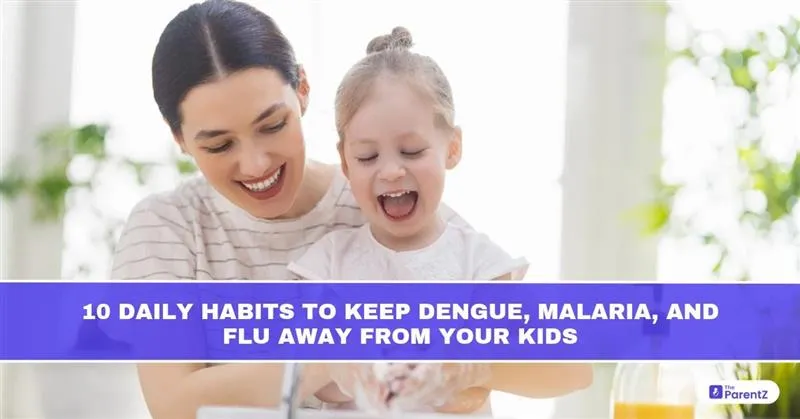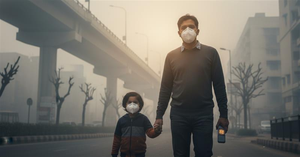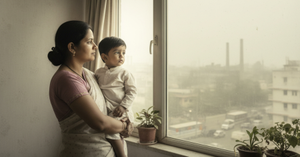In India’s tropical climate, the monsoon season often brings with it a surge in dengue, malaria, and viral flu cases, especially among children. Poor drainage, stagnant water, fluctuating temperatures, and high humidity create the perfect breeding ground for mosquitoes and airborne viruses.
But prevention doesn’t always need complex solutions; it starts at home, with simple daily habits. These habits, rooted in both pediatric and public health guidelines, form the first line of defense against seasonal infections.
1. Apply Mosquito Repellent: Every Morning and Evening
Mosquitoes that transmit dengue (Aedes aegypti) are day-biters, while malaria mosquitoes (Anopheles) are more active after dusk.
Best practice:
- Use pediatric-safe repellents (DEET <10%, picaridin, or lemon-eucalyptus oil) on exposed skin.
- Reapply every 6–8 hours or as directed.
- Avoid strong chemical coils in poorly ventilated rooms.
Note: WHO and ICMR recommend repellents as a key preventive tool in high-transmission zones.
2. Dress Your Child in Light-Colored, Full-Sleeved Clothes
This reduces the exposed skin surface and also makes it easier to spot mosquitoes.
Tips:
- Use cotton fabrics to prevent sweat rashes.
- Avoid dark colors, mosquitoes are more attracted to black and navy.
- Ensure clothes are clean and dry to avoid dampness-related fungal infections.
3. Give a Warm Bath Every Evening
Evening showers help remove sweat, germs, and allergens that accumulate through the day.
Why it helps:
- Lowers body temperature and soothes minor viral symptoms.
- Reduces bacterial and fungal overgrowth on skin.
- Use antibacterial, pediatric-safe cleansers if your child is out in the rain or muddy areas.
4. Make a Habit of Daily Room Checks for Stagnant Water
A mere spoonful of water left undisturbed for a few days can breed mosquito larvae.
Routine:
- Check flower pots, fridge trays, AC drip trays, buckets, and bird bowls.
- Clean water tanks weekly and cover them tightly.
- Educate older children to alert you when they spot puddles or water accumulation.
5. Offer Fresh, Homemade Meals Only
Contaminated or stale food is a major cause of gastroenteritis and flu-like symptoms in children during the monsoon.
Daily habit:
- Cook small, fresh meals. Avoid outside snacks.
- Use filtered water for drinking and cooking.
- Wash fruits and veggies in salt or potassium permanganate solution.
6. Sanitize Frequently-Touched Objects and Toys
Viruses like influenza and respiratory syncytial virus (RSV) can live on surfaces for hours.
Must-clean items:
- Toys, water bottles, lunch boxes, mobile phones, door handles
- Use child-safe disinfectant sprays or mild soap solution
- Ensure daily hand hygiene before and after playtime
7. Teach Proper Cough and Sneezing Etiquette
Respiratory viruses spread fast in crowded environments like schools and buses.
Daily reminders:
- Cover mouth with elbow while sneezing or coughing
- Use disposable tissues or handkerchiefs
- Avoid touching nose and eyes with unwashed hands
CDC data shows that consistent respiratory hygiene can reduce flu transmission by 25–40%.
8. Boost Immunity Through Morning Sun and Movement
Low vitamin D levels in children are linked to more frequent infections, especially during the monsoon when sunlight exposure is reduced.
Daily immunity habits:
- 15–20 minutes of early morning sun exposure (before 9:30 AM)
- Gentle indoor yoga or stretching to stimulate lymphatic flow
- Ensure 8–10 hours of sleep for immune system regulation
9. Avoid School if Your Child Has Fever or Viral Symptoms
Sending a sick child to school can spread flu or viral infections to others and worsen your child’s recovery.
What to watch:
- Fever, chills, rash, joint pain (possible dengue/malaria)
- Runny nose, sore throat, fatigue (viral flu)
- Sudden vomiting or diarrhea
Keep your child home and consult a pediatrician if symptoms persist beyond 48 hours.
10. Install Window Screens and Use Bed Nets
A preventive step backed by the Ministry of Health & Family Welfare, these barriers are simple but effective.
Best practice:
- Use fine mesh screens on windows and balconies
- Install mosquito nets over beds and baby cribs
- Use plug-in vaporizers in areas with high mosquito density
Bonus Tip: Know the Warning Signs
Even with the best prevention, children may fall ill. Early detection is key.
- Dengue: High fever, red rashes, joint pain, bleeding gums
- Malaria: Recurrent fever with chills, sweating, vomiting
- Flu: Sudden fatigue, body aches, cough, sore throat
Immediate medical attention is needed if your child has poor appetite, low urine output, confusion, or persistent vomiting.
Conclusion
Keeping dengue, malaria, and flu away from your child doesn’t require fancy measures; it’s about consistent, conscious daily habits. These ten simple routines can significantly reduce your child’s exposure to infection and support a faster recovery if illness strikes.
By following these steps and staying alert to early symptoms, you can keep your child safe, healthy, and cheerful through even the riskiest seasons.
References
- Indian Council of Medical Research (ICMR) Guidelines on Dengue & Malaria Prevention
- CDC Pediatric Flu Prevention Toolkit
- Ministry of Health and Family Welfare, Government of India – Vector-Borne Disease Control Programme
- WHO Guidelines on Environmental Management for Vector Control








Be the first one to comment on this story.